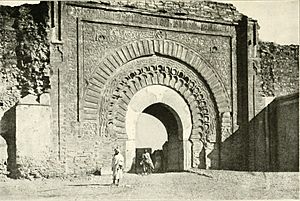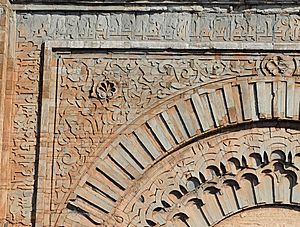Bab Agnaou facts for kids
Quick facts for kids Bab Agnaou |
|
|---|---|
|
باب اكناو (Arabic)
ⵜⴰⵡⵓⵔⵜ ⴰⴳⵏⴰⵡ (Berber) |
|
 |
|
| Alternative names | Bab al Kohl, Bab al Qasr |
| General information | |
| Type | City Gate |
| Architectural style | Almohad, Moroccan |
| Location | Rue Moulay Ismail, Marrakesh |
| Coordinates | 31°37′03″N 7°59′27″W / 31.6175°N 7.9907°W |
| Completed | 1188–1190 |
| Technical details | |
| Material | sandstone, brick |
Bab Agnaou (Arabic: باب اكناو; Berber languages: ⵜⴰⵡⵓⵔⵜ ⴰⴳⵏⴰⵡ) is a very famous gate in the city of Marrakesh, Morocco. It was built a long time ago, around 1188 or 1190. The gate was made by the Almohad ruler Abu Yusuf Yaqub al-Mansur.
This gate was the main public entrance to the royal kasbah. A kasbah is like a fortified city or citadel. This royal area is in the southern part of Marrakesh's old city, called the medina. The kasbah was also built by Yaqub al-Mansur. Inside, you can find the El Mansouria Mosque and the Saadian Tombs. The El Badi Palace and the main Royal Palace are also nearby.
Contents
What Does Bab Agnaou Mean?
The word bab comes from Arabic and means 'Gate' or 'Door'. The name agnaou is thought to be from the Berber language. It has had different meanings over time. Some thought it meant "mutes" or "people who cannot speak". Later, it was used to mean "Black people" or the Gnawa people.
It is not fully clear what the name meant for this gate. It might also mean "a sheep without horns". The idea of it referring to the Gnawa might be because the gate faces partly south. This direction looks towards sub-Saharan Africa, where many Gnawa people came from.
The gate also had other names. It was called Bab al-Qasr, which means "Gate of the Palace". Another name was Bab al-Kuhl, meaning "Gate of Kohl".
How Was Bab Agnaou Designed?
Bab Agnaou is located just inside the main city walls. It is near another gate called Bab er-Robb. The gate's main job was to look beautiful, as it was already inside the city.
When it was first built, the gate had two strong towers on its sides. These towers had merlons, which are the solid parts of a castle wall. The path through the gate was a bent entrance. This means you had to turn 90 degrees to go through it. The passage went through a large, arched room.
There was also a terrace on top of the gate. You could reach it by an inside staircase. This original design was like other big Almohad gates, such as Bab er-Rouah in Rabat.
Over time, the towers and the covered room have disappeared. The main arch of the gate has also been partly filled in. Now, it has a smaller, simpler brick arch. This change probably happened during the time of Sultan Sidi Muhammad ibn Abdallah. He did a lot of building work in the kasbah area. The small open courtyard behind the gate today was also added later.
Even with these changes, the gate still has its amazing stone carvings. These carvings are from the Almohad period. The front of the gate is made of sandstone. This stone likely came from the Gueliz area near Marrakesh.
The original arch has beautiful patterns around it. These patterns include lines that spread out and designs that weave together. The corner areas, called spandrels, have flower designs (arabesques). Each flower design has a carved shell in the middle.
All these decorations are framed by a long border. This border has words from the Quran carved into it. The writing is in a special style called foliated Kufic letters. On each side of the decorated front, there are flat columns called pilasters. Some people thought these held up a canopy or awning. However, many experts believe they were just for decoration. They helped connect the decorated front to the towers that used to be on the sides of the gate.
How Bab Agnaou Is Being Preserved
The stone of the gate has worn down over time. Some of the stone decorations at the top have been damaged. Experts believe this is partly because of salts in the mortar used to fix the stones. Air pollution in the area also has a bad effect on the gate. Efforts are being made to protect this important historical site.
See also
 In Spanish: Bab Agnaou para niños
In Spanish: Bab Agnaou para niños
- Bab Ksiba
- Giralda
- Hassan Tower
- Koutoubia Mosque
- Menara gardens



